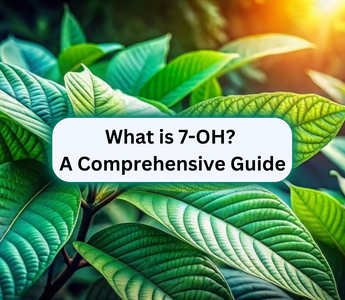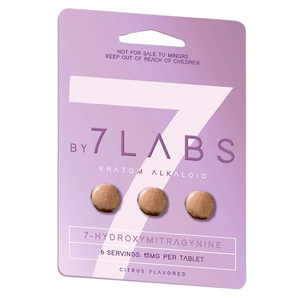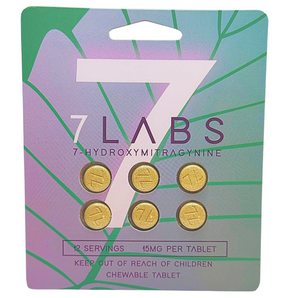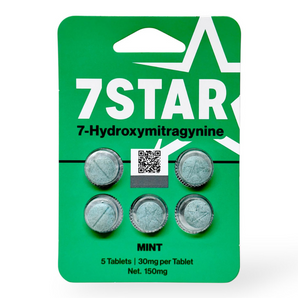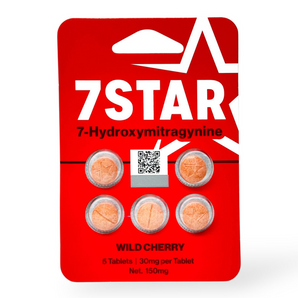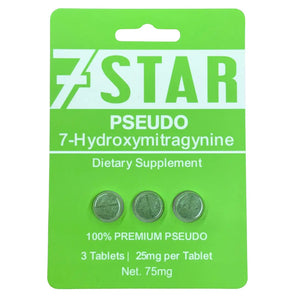Introduction to 7-OH
7-OH, also known as 7-hydroxymitragynine, is a naturally occurring alkaloid found in Mitragyna speciosa, commonly known as kratom. This compound is a metabolite of mitragynine, the primary active alkaloid in kratom. It is known for its potent interaction with mu-opioid receptors, contributing to kratom's analgesic and sedative effects. Due to its strength and potential impact on the body, 7OH has become a subject of scientific research and regulatory scrutiny.
Studies indicate that 7-OH is 13 to 46 times more potent than morphine in animal models, making it one of the strongest naturally occurring kratom alkaloids.
Chemical Structure and Properties of 7-OH
- Molecular Formula: C23H30N2O4
- Molecular Weight: 398.5 g/mol
- Solubility: Soluble in organic solvents like ethanol, chloroform, and DMSO
-
Structural Features:
- Hydroxyl (-OH) group enhances its potency
- Derived from mitragynine through oxidation
- Lipophilic nature allows it to cross the blood-brain barrier efficiently
The presence of a hydroxyl group at the 7th position makes 7-hydroxymitragynine significantly more potent at opioid receptors compared to its precursor, mitragynine. This modification alters its pharmacodynamics, leading to a stronger analgesic effect.
Think of 7-OH like turbocharged fuel in a sports car—while mitragynine provides steady power, 7-OH kicks in with an amplified effect, accelerating the compound’s interaction with opioid receptors.

Source: Screening and Identification of Mitragynine and 7-Hydroxymitragynine
Natural Occurrence of 7-OH
7-OH is a minor alkaloid in kratom, occurring in trace amounts naturally. Unlike mitragynine, which is found in much higher concentrations in kratom leaves, 7OH is primarily produced during the metabolism of mitragynine in the body. Some important points regarding its natural occurrence include:
- Found in extremely low levels in fresh kratom leaves.
- Formed primarily in the human body after ingestion of mitragynine.
- The oxidation process leading to 7-OH happens naturally due to enzymatic reactions.
Since its presence in kratom is minimal, many studies suggest that 7-OH is not the primary contributor to kratom’s effects but rather a byproduct of metabolism.
Metabolism of Mitragynine to 7-OH in Humans
The human body converts mitragynine into 7-OH through metabolic processes involving liver enzymes, particularly cytochrome P450 enzymes. This conversion plays a key role in how kratom exerts its effects:
- Mitragynine is absorbed in the gastrointestinal tract.
- It undergoes phase I metabolism, where enzymes oxidize it to 7-hydroxymitragynine.
- 7-OH has a higher affinity for mu-opioid receptors than mitragynine.
- The conversion rate varies depending on genetics, liver function, and enzyme activity.
This metabolic process explains why kratom’s potency may differ between individuals based on how efficiently their body produces 7OH.
Pharmacological Effects of 7-OH

Source: ACS Central Science
1. Mu-Opioid Receptor Activation
7-OH is significantly more potent at activating mu-opioid receptors than mitragynine. This results in:
- Strong analgesic (pain-relieving) effects
- Sedative properties that may induce relaxation and drowsiness
- Potential for opioid-like euphoria, though less pronounced than synthetic opioids
Research suggests that 7-OH binds to mu-opioid receptors 17 times more effectively than morphine, leading to its intense analgesic effects.
2. Comparison with Other Compounds
| Compound | Mu-Opioid Receptor Affinity | Potency (Compared to Morphine) |
|---|---|---|
| Morphine | High | 1x |
| Mitragynine | Moderate | 10x weaker than morphine |
| 7-OH | Very High | 5-10x stronger than morphine |
These comparisons highlight why 7OH is often considered one of the most pharmacologically active components of kratom.
Potential Therapeutic Uses of 7-OH
Given its potent opioid-receptor activity, 7-OH has been studied for potential medical applications:
- Pain Management: Its high potency at mu-opioid receptors makes it a potential candidate for chronic pain relief.
- Opioid Alternative: Researchers are investigating its use as a safer alternative to traditional opioids.
- Treatment for Opioid Withdrawal: Some studies suggest that 7-OH could help manage opioid withdrawal symptoms by providing relief without the same level of respiratory depression associated with synthetic opioids.
While the therapeutic potential of 7OH is promising, its potency and similarity to opioids raise concerns about possible dependence and abuse. More research is needed to determine its safety and long-term effects.
Risks and Side Effects Associated with 7-OH
While 7-hydroxymitragynine (7-OH) offers potent analgesic effects, it also presents potential risks and side effects similar to opioid compounds. These risks have been a major focus of regulatory and medical discussions.
1. Potential for Physical Dependence and Addiction
- 7-OH has high affinity for mu-opioid receptors, making it significantly more addictive than its precursor, mitragynine.
- Frequent use may lead to tolerance, requiring higher doses for the same effect.
- Users have reported withdrawal symptoms similar to opioids, including:
- Muscle aches
- Insomnia
- Nausea and vomiting
- Anxiety and irritability
2. Respiratory Depression Concerns
One of the most significant dangers of opioids is respiratory depression—a slowing of breathing that can be fatal in high doses. While kratom itself is not known to cause severe respiratory depression, 7-OH has been linked to:
- Reduced breathing rate in high doses
- Potential risk when combined with alcohol, benzodiazepines, or other depressants
- Cases of overdose reported when mixed with other substances
3. Other Reported Side Effects
- Dizziness and sedation – Due to its strong opioid activity, 7OH can cause excessive drowsiness.
- Nausea and vomiting – Common in high doses or in individuals with opioid sensitivity.
- Gastrointestinal distress – May lead to constipation, similar to traditional opioids.
- Mental fog and cognitive impairment – Users have reported difficulty concentrating or memory issues after frequent use.
Regulatory Status of 7-OH
The legal landscape surrounding 7-OH is complex, as it falls under kratom regulations in many countries.
1. U.S. Regulatory Status
- The FDA has classified kratom and its alkaloids as a substance of concern but has not scheduled 7-OH under the Controlled Substances Act.
- The DEA attempted to schedule kratom and 7-OH as a Schedule I substance in 2016, but this was put on hold after public outcry and scientific opposition.
- Several states (Alabama, Arkansas, Wisconsin, etc.) have banned kratom, making possession of 7-OH illegal in those jurisdictions.
2. International Restrictions
- Australia & New Zealand – Kratom and 7OH are classified as prohibited substances.
- United Kingdom – 7OH is considered illegal under the Psychoactive Substances Act.
- European Union – Several member states have imposed bans or restrictions on kratom and its alkaloids.
The uncertain legal status of 7-OH makes it difficult to conduct large-scale clinical trials, slowing research into its potential benefits and risks.
Recent Developments and Market Trends
1. Emergence of Semi-Synthetic 7-OH Products
- Some vendors have started isolating and selling 7-OH extracts, which are much more potent than natural kratom.
- There is growing concern that these semi-synthetic derivatives may lead to stronger dependency and legal scrutiny.
2. Differences from Traditional Kratom Preparations
- Most kratom users consume raw leaf powder, which contains only trace amounts of 7-OH.
- Some enhanced kratom extracts artificially increase 7-OH content, making the effects stronger and riskier.
3. Consumer Safety and Market Implications
- Many kratom advocacy groups argue that isolating 7-OH increases regulatory pressure on kratom as a whole.
- Vendors are self-regulating by providing lab-tested kratom with natural alkaloid levels rather than altered extracts.
- Future market regulations may involve banning high-potency kratom extracts while allowing natural kratom use.
Frequently Asked Questions (FAQs) About 7OH
1. What is 7-OH and how is it different from mitragynine?
7-OH (7-hydroxymitragynine) is a metabolite of mitragynine, the main alkaloid in kratom. It is significantly more potent in binding to opioid receptors, resulting in stronger analgesic effects.
2. Is 7-OH legal?
The legal status of 7-OH varies by country and state. In the U.S., kratom is legal in most states, but 7-OH may fall under controlled substance laws in areas where kratom is banned.
3. Does 7-OH cause addiction?
Yes, 7-OH has a higher potential for addiction and dependence than natural kratom due to its strong opioid receptor activity. However, when consumed in natural kratom leaves, the risk is lower.
4. What are the side effects of 7-OH?
Potential side effects include drowsiness, nausea, dizziness, respiratory depression, and withdrawal symptoms in long-term users.
5. Can 7-OH be used for pain management?
Due to its strong analgesic properties, 7-OH is being researched as a potential pain management alternative. However, its legal status and risk of dependence make it a controversial option.
Conclusion
In this article, we have explored the structure, metabolism, pharmacology, risks, and regulations surrounding 7-OH. While 7-hydroxymitragynine offers potent pain relief and therapeutic potential, its strong opioid-like activity raises concerns about dependence and regulation.
As research continues, the future of 7OH remains uncertain. While kratom itself is widely used, high-potency extracts and synthetic derivatives may face increased scrutiny and regulation.
If you are considering using kratom products, it is crucial to understand the risks, legality, and potential for addiction before making a decision.

